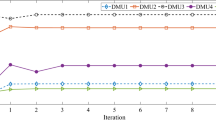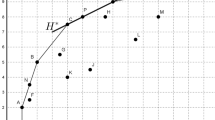Abstract
Numerous corporations are composed of several branches working in parallel regions, and the branches in regional markets are involved in the winner-take-all competition. This paper extends data envelopment analysis (DEA) method to the performance evaluation for those corporations. Firstly, a DEA model is proposed to calculate actual efficiencies of regional branches, where the market demands are considered as nontechnical constraints. Secondly, a winner-take-all evaluation is introduced to assess the overall performance of corporations. In the evaluation, analytic hierarchy process is used to obtain weights indicating regions’ relative importance, and values are assigned to regions according to their weights. Then branches in each region divide the assigned value based on a function reflecting the winner-take-all principle, i.e., a few winners get absolute majority of the value. The total values corporations obtain are employed to compare their overall performances. Our method not only presents the competitiveness and the development potential of corporations, but also helps managers to make more reasonable productivity allocations and effectively avoid the overcapacity. A numerical example is designed to illustrate our method.




Similar content being viewed by others
References
Ang, S., & Chen, C. M. (2016). Pitfalls of decomposition weights in the additive multi-stage DEA model. Omega, 58, 139–153.
Aparicio, J., Ortiz, L., & Pastor, J. T. (2017). Measuring and decomposing profit inefficiency through the slacks-based measure. European Journal of Operational Research, 260(2), 650–654.
Azadeh, A., Ghaderi, S. F., & Izadbakhsh, H. (2008). Integration of DEA and AHP with computer simulation for railway system improvement and optimization. Applied Mathematics and Computation, 195(2), 775–785.
Banker, R. D., Charnes, A., & Cooper, W. W. (1984). Some models for estimating technical and scale inefficiencies in data envelopment analysis. Management Science, 30(9), 1078–1092.
Beasley, J. E. (1995). Determining teaching and research efficiencies. Journal of the Operational Research Society, 46(4), 441–452.
Castelli, L., Pesenti, R., & Ukovich, W. (2004). DEA-like models for the efficiency evaluation of hierarchically structured units. European Journal of Operational Research, 154(2), 465–476.
Castelli, L., Pesenti, R., & Ukovich, W. (2010). A classification of DEA models when the internal structure of the decision making units is considered. Annals of Operations Research, 173(1), 207–235.
Charnes, A., & Cooper, W. W. (1984). The non-Archimedean CCR ratio for efficiency analysis: A rejoinder to Boyd and Färe. European Journal of Operational Research, 15(3), 333–334.
Charnes, A., Cooper, W. W., & Rhodes, E. (1978). Measuring the efficiency of decision making units. European Journal of Operational Research, 2(6), 429–444.
Charnes, A., Cooper, W. W., & Rhodes, E. (1979). Measuring the efficiency of decision-making units. European Journal of Operational Research, 3(4), 339.
Chen, Y., Cook, W. D., Li, N., & Zhu, J. (2009). Additive efficiency decomposition in two-stage DEA. European Journal of Operational Research, 196(3), 1170–1176.
Chen, C., & Yan, H. (2011). Network DEA model for supply chain performance evaluation. European Journal of Operational Research, 213(1), 147–155.
Cook, W. D., Tone, K., & Zhu, J. (2014). Data envelopment analysis: Prior to choosing a model. Omega, 44, 1–4.
Cook, W. D., Zhu, J., Bi, G., & Yang, F. (2010). Network DEA: Additive efficiency decomposition. European Journal of Operational Research, 207(2), 1122–1129.
Dyson, R. G., Allen, R., Camanho, A. S., Podinovski, V. V., Sarrico, C. S., & Shale, E. A. (2001). Pitfalls and protocols in DEA. European Journal of Operational Research, 132(2), 245–259.
Färe, R., & Grosskopf, S. (2000). Network dea. Socio-Economic Planning Sciences, 34(1), 35–49.
Frank, R. H. (1999). Higher education: The ultimate winner-take-all market? CHERI Working Paper #2. Retrieved August 2016, from Cornell University, ILR School site: http://digitalcommons.ilr.cornell.edu/cheri/2.
Golden, B. L., Wasil, E. A., & Harker, P. T. (1989). The analytic hierarchy process. New York: Springier.
Hacker, J. S., & Pierson, P. (2011). Winner-take-all politics: How Washington made the rich richer–and turned its back on the middle class. New York: Simon and Shuster.
Huang, J., Wei, K. D., & Yan, H. (2007). Participation costs and the sensitivity of fund flows to past performance. The Journal of Finance, 62(3), 1273–1311.
Kao, C. (2009). Efficiency measurement for parallel production systems. European Journal of Operational Research, 196(3), 1107–1112.
Kao, C., & Hwang, S. N. (2008). Efficiency decomposition in two-stage data envelopment analysis: An application to non-life insurance companies in Taiwan. European Journal of Operational Research, 185(1), 418–429.
Kao, C., & Hwang, S. N. (2010). Efficiency measurement for network systems: IT impact on firm performance. Decision Support Systems, 48(3), 437–446.
Lee, E., Lee, J., & Lee, J. (2006). Reconsideration of the winner-take-all hypothesis: Complex networks and local bias. Management Science, 52(12), 1838–1848.
Liang, L., Cook, W. D., & Zhu, J. (2008). DEA models for two-stage processes: Game approach and efficiency decomposition. Naval Research Logistics, 55(7), 643–653.
Lin, M. I., Lee, Y. D., & Ho, T. N. (2011). Applying integrated DEA/AHP to evaluate the economic performance of local governments in China. European Journal of Operational Research, 209(2), 129–140.
Mirhedayatian, S. M., Azadi, M., & Saen, R. F. (2014). A novel network data envelopment analysis model for evaluating green supply chain management. International Journal of Production Economics, 147, 544–554.
Saaty, T. L. (1986). Axiomatic foundation of the analytic hierarchy process. Management Science, 32(7), 841–855.
Saaty, T. L. (1990). How to make a decision: The analytic hierarchy process. European Journal of Operational Research, 48(1), 9–26.
Sarrico, C. S., & Dyson, R. G. (2004). Restricting virtual weights in data envelopment analysis. European Journal of Operational Research, 159(1), 17–34.
Tan, Y., Zhang, Y., & Khodaverdi, R. (2016). Service performance evaluation using data envelopment analysis and balance scorecard approach: An application to automotive industry. Annals of Operations Research, 248, 1–22.
Yang, T., & Kuo, C. (2003). A hierarchical AHP/DEA methodology for the facilities layout design problem. European Journal of Operational Research, 147(1), 128–136.
Zanella, A., Camanho, A. S., & Dias, T. G. (2015). Undesirable outputs and weighting schemes in composite indicators based on data envelopment analysis. European Journal of Operational Research, 245(2), 517–530.
Zhao, L., Zha, Y., Wei, K., & Liang, L. (2016). A target-based method for energy saving and carbon emissions reduction in China based on environmental data envelopment analysis. Annals of Operations Research, 255, 1–24.
Acknowledgements
The research is supported by the National Natural Science Foundation of China (Nos. 71631006, 71601173), the National Soft Science Research Program (No. 2013GXS1D006), the China Postdoctoral Science Foundation (Nos. 2015M580556, 2016T90588), Philosophy and Social Science Project of Anhui Province (No. AHSKY2014D28), and the Fundamental Research Funds for the Central Universities.
Author information
Authors and Affiliations
Corresponding author
Rights and permissions
About this article
Cite this article
Yang, F., Jiang, L. & Ang, S. A winner-take-all evaluation in data envelopment analysis. Ann Oper Res 278, 141–158 (2019). https://doi.org/10.1007/s10479-018-2833-z
Published:
Issue Date:
DOI: https://doi.org/10.1007/s10479-018-2833-z




